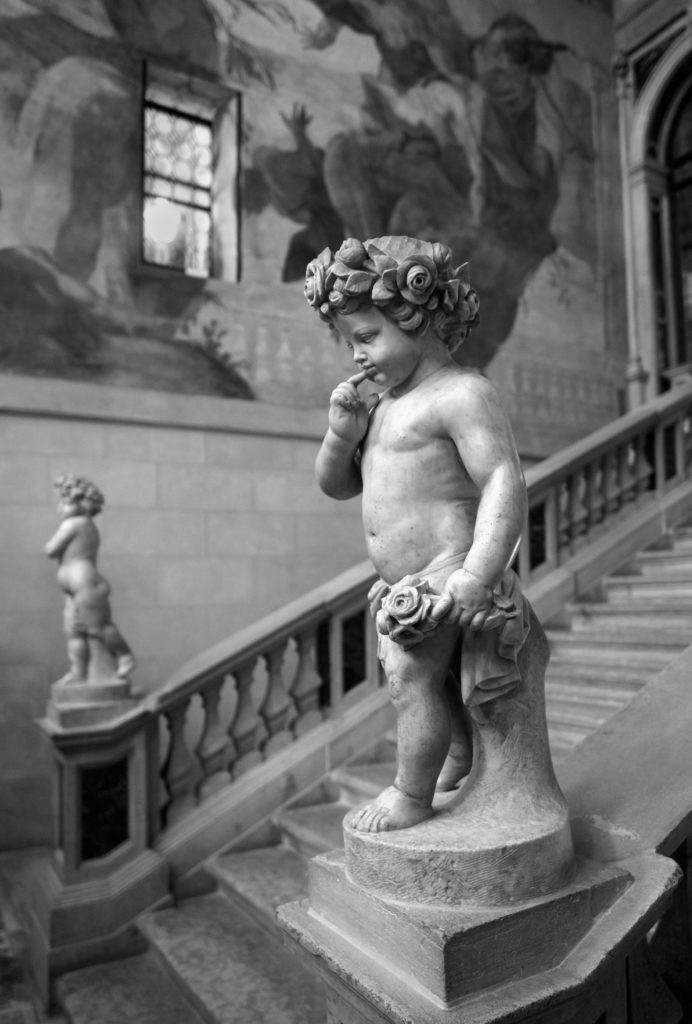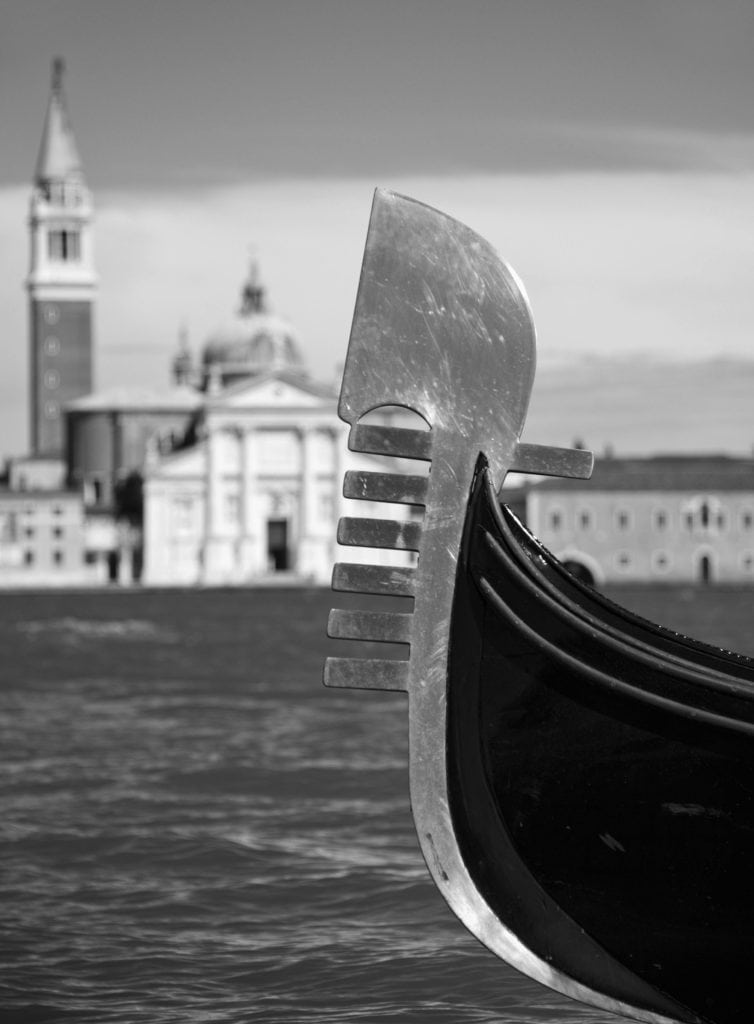Arriving in the afternoon from London, I took a water taxi into the city. It’s a great way to arrive with passing boats throwing up spray as they speed past and I was in a high state of excitement by the time I reached my hotel, the Ca’ Sagredo, as this was also a much anticipated first visit to Venice. The hotel is a very well-preserved former 15th century palazzo situated in the Cannaregio district – the largest of the six districts that make up the city. It is on the Grand Canal and opposite the Rialto Market. it is, quite deservedly, a national monument.
I was most taken by the staircase with its marble cherubs and Scalone die Giganti (Fall of the Giants) frescoes, which I thought was one of the great interior sights of my trip. During my stay I spent a considerable amount of time photographing the staircase with my Leica Q and eventually I was pleased with the shot that accompanies this post.

The hotel is right next to a Gondola station; you can take the traghetto across to the area of the Rialto market for the tourist rate of 2 Euros (locals pay 70 cents), something I ended up doing frequently.
As soon as I had dropped my bags I took a Gondola trip down to the mouth of Grand Canal. I was captivated by the Baroque Santa Maria della Salute. The domed basilica is one of the symbols of the city and was built as a response to the plague which decimated the city in the 17th century. The basilica still hosts the annual Festa della Madonna della Salute each November, which gives thanks for the intercession of the Virgin Mary to end the plague.
Returning to the hotel in the Gondola, I explored the local area, walking across the famous Ponte di Rialto (Rialto Bridge) which connects the districts of San Marco and San Polo. Up until 1854 this was the only bridge across the Grand Canal and there are still only 4 bridges along its 3.8 km length. Later I walked up the Strada Nova, one of the main streets in the city.
In the evening I ventured out once more and had drinks at the Gritti Palace, another 15th century former palace, once owned by Andrea Gritti, doge of Venice from 1523 to 1538. This hotel is one of the most expensive in the city and has some of the best views as it is opposite the Santa Maria della Salute church. Watching the Gondolas go past as the sun starts to go down from the hotel terrace is a great experience.
I walked back towards the Ca’ Sagredo and had dinner at the modest Osteria dal Riccio Peoco in the local square, Campo San Apostoli, which was inexpensive and delicious.

The next day, I took a a second Gondola ride, during which I photographed many sites, Gondolas and Gondoliers. I noticed they were speaking a language that didn’t sound like standard Italian to me and asked the Gondolier about it. He said they were speaking in Venetian dialect, which is actually a language and spoken around the Veneto region. We passed under the white limestone Bridge of Sighs that connects the Doge’s Palace to the prison opposite. It was Lord Byron who gave the bridge this name – the suggestion being that prisoners would sigh at their final view of Venice before incarceration or execution. Like many stories that give rise to names it isn’t true, but the bridge is still used to transport low risk offenders to prison.
Returning to the hotel I set off to walk around the lagoon city. I enjoyed seeing the winged lion in Campo Manin, a large bronze sculpture at the base of a statue of Daniele Manin – a hero of Italian unification. The winged lion is the Lion of Saint Mark, and is the symbol both of the city of Venice and of the Venetian Republic.
I found the Leaning Tower of Santo Stefano, a 13th century, 66m brick-built gothic bell tower located in the Sestiere San Marc. Though much less famous, its inclination is remarkably similar to that of the Tower of Pisa, at about 2 meters out of kilter. After the crowds of much of the city that day the square was extremely quiet. I passed through it a couple of times after that and it was always close to deserted.
Next I visited Piazza San Marco, both the grand showpiece and principle square of the city. There’s a lot to take in including St Mark’s Basilica, The Doge’s Palace, the Clock Tower and the columns of Saint Mark and Saint Theodore. I walked the square and took in the entrancing view stopping for a coffee at Caffè Florian, one of the world’s oldest coffee houses. Later, I lunched nearby at Ostaria La Campana, a local’s place right in the midst of a tourist area.
As it was getting to that time of the evening I thought a Daqueri at Harry’s Bar would be a good idea. Sadly it wasn’t. I paid a visit, but I think I missed the time when it was a good place to go by many years. It’s a pretty terrible place now, as many online reviews attest. I paid the eye watering price for an OK Daiquiri to the aloof barman and left the place as fast as I could.

Close by the view of the the Santa Maria della Salute church beckoned at the Gritti Palace. I had a drink there and then dinner on the balcony at the Club del Doge. The view of such a beautiful church with gondolas gliding past and the sun going down plus a decent risotto (a Hemingway variant with scampi) meant I didn’t begrudge the hefty bill.
The next day city I took the river bus down to the Dorsoduro Sestiere to visit the museums there and to see the Santa Maria della Salute church land side. The Gallerie dell’Academia was my first stop. Here I enjoyed the neoclassical sculptures of Antonio Canova , took in Hieronymus Bosch’s disturbing Visions of the Hererafter and walked around a room dedicated to Lord Byron in Venice.
Lord Byron lived in Venice after he was forced to leave England to flee the many debts and scandals caused by his aristocratic excesses. He conducted his Venetian affairs in some style from a Grand Canal palazzo with his many servants and a menagerie that included monkeys, a wolf, a fox, a crow and an eagle. Seeking distraction and mental stimulation he also studied the Armenian language at a monastery on the tiny island of San Lazzaro in the lagoon.
After that I walked to the Peggy Guggenheim Collection, a modern art museum housed an 18th-century palazzo, which was once the home of the American heiress. it is full of cubist, surrealist and abstract expressionist work. I was most impressed by the works of by Picasso, Dali, Yves Tanguy, Max Ernst and Alberto Burri.
I spent the evening walking along the canals in the Cannaregio Sestiere, the northernmost of the six districts of Venice, walking along the Fondamenta della Misericordia/degli Ormesini/Capuccine. It is a beautiful area to walk around. It was quiet until sunset when it become quite lively though I still managed to find a Cicchetti place I could sit outside at.
Early on my last morning I went back to the Rialto Market, the city’s ancient main market, to see the fish market in full swing before my water taxi arrived. There has been a market there since 1097 and it is still going strong. I love the theatre of fish markets and enjoy visiting them wherever I can find them. Mid morning my water taxi arrived and took me to the station where I took the train to Densezano to spend a few days in Sirmione.